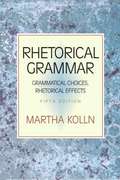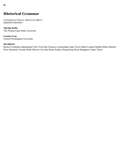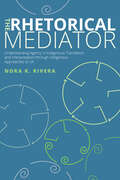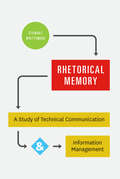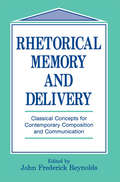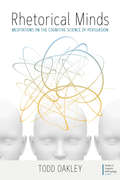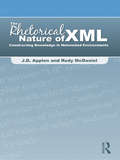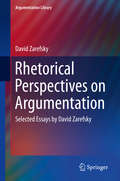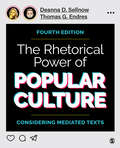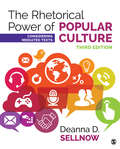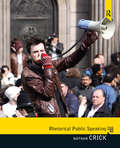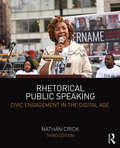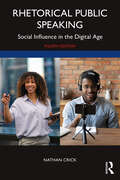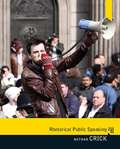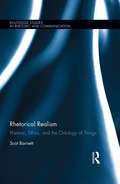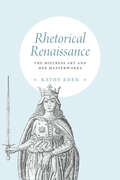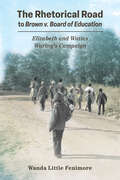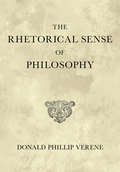- Table View
- List View
Rhetorical Grammar: Grammatical Choices, Rhetorical Effects
by Martha KollnThis detailed guide encourages writers to recognize and use the grammatical and stylistic choices available to them and to understand the rhetorical effects those choices can have on their readers.
Rhetorical Grammar: Grammatical Choices, Rhetorical Effects
by Martha Kolln Loretta GrayRhetorical Grammar encourages writers to recognize and use the grammatical and stylistic choices available to them, and to understand the rhetorical effects of those choices on their readers. Kolin and Gray ask students to regard sentence structure as a toolkit – and its application an artful way to elicit a desired emotion or reaction – rather than a list of tedious rules to remember. In this way, grammar is defined as an intellectual exercise that opens students' minds to the versatility, beauty, and possibilities of language. <p><p>The Eighth Edition offers a more intuitive content organization, updated passage selections, and current exercises and examples. It maintains its hallmark revision strategies and systematic discussions about reader expectations, sentence rhythm and cohesion, subordination and coordination, punctuation, modification, diction, and many other essential principles.
The Rhetorical Mediator: Understanding Agency in Indigenous Translation and Interpretation through Indigenous Approaches to UX
by Nora K. RiveraThe Rhetorical Mediator reveals how and why scholars and user experience (UX) researchers can include Indigenous technical communicators and oral interpretation practices in their interdisciplinary conversations. Nora Rivera analyzes the challenges that Indigenous interpreters and translators face in Peru, Mexico, and the United States as a means of understanding their agency and examines the various ways in which technical and professional communication, translation and interpreting studies, and UX research can better support the practices of Indigenous interpreters and translators. In places where Indigenous language translation and interpretation are greatly needed, Indigenous language mediators often lack adequate systems to professionalize their field while withstanding Western practices that do not align with their worldviews. Through a “design thinking” methodology based on her work organizing and participating in an Indigenous-focused interpreter and translator conference, Rivera examines testimonios and semi-structured interviews conducted with Indigenous interpreters and translators to emphasize dialogue and desahogo (emotional release) as Indigenous communication practices. The Rhetorical Mediator advocates for Indigenous language practices that have been sidelined by Western scholarship and systems, helping to create more equitable processes to directly benefit Indigenous individuals and other underrepresented groups. This book benefits specialists, including UX researchers, technical and professional communicators, interpreters and translators, and Indigenous professionals, as well as academics teaching graduate and undergraduate methods, Indigenous rhetoric and translation, and UX courses.
Rhetorical Memory: A Study of Technical Communication and Information Management
by Stewart WhittemoreInstitutions have regimes--policies that typically come from the top down and are meant to align the efforts of workers with the goals and mission of an institution. Institutions also have practices--day-to-day behaviors performed by individual workers attempting to interpret the institution's missives. Taken as a whole, these form a company's memory regime, and they have a significant effect on how employees analyze, mix, translate, sort, filter, and repurpose everyday information in order to meet the demands of their jobs, their customers, their colleagues, and themselves. In Rhetorical Memory, Stewart Whittemore demonstrates that strategies we use to manage information--techniques often acquired through trial and error, rarely studied, and generally invisible to us--are as important to our success as the end products of our work. First, he situates information management within the larger field of rhetoric, showing that both are tied to purpose, audience, and situation. He then dives into an engaging and tightly focused workplace study, presenting three cases from a team of technical communicators making use of organizational memory during their everyday work. By examining which techniques succeed and which fail, Whittemore illuminates the challenges faced by technical communicators. He concludes with a number of practical strategies to better organize information, that will help employees, managers, and anyone else suffering from information overload.
Rhetorical Memory and Delivery: Classical Concepts for Contemporary Composition and Communication (Routledge Communication Series)
by John Frederick ReynoldsWhy has classical rhetoric been a subject of such growing interest for the past ten years? Because the most exciting work in classical rhetoric has asked us to rethink classical concepts in modern terms. What's been missing, at least in book-length form, is a scholarly rethinking of rhetorical memory and delivery. As many scholars have been noting in their work for some time now, three of five classical issues -- invention, arrangement, and style -- have dominated rhetorical studies while the other two -- memory and delivery -- have largely been misunderstood or ignored. Re-examined in light of recent research on orality, literacy, and electronic technology, rhetorical memory and delivery issues can become not only central to the field but also key to the continued interest in classical rhetoric. Bringing together national scholars from a variety of related disciplines in which rhetorical memory and delivery issues matter, this collection is the only volume that examines classical and contemporary interpretations of rhetorical memory and delivery in depth and detail.
Rhetorical Minds: Meditations on the Cognitive Science of Persuasion (Studies in Linguistic Anthropology #1)
by Todd OakleyMinds are rhetorical. From the moment we are born others are shaping our capacity for mental agency. As a meditation on the nature of human thought and action, this book starts with the proposition that human thinking is inherently and irreducibly social, and that the long rhetorical tradition in the West has been a neglected source for thinking about cognition. Each chapter reflects on a different dimension of human thought based on the fundamental proposition that our rhetoric thinks and acts with and through others.
The Rhetorical Nature of XML: Constructing Knowledge in Networked Environments
by J.D. Applen Rudy McDanielThe Rhetorical Nature of XML is the first volume to combine rhetoric, XML, and knowledge management in a substantive manner. It serves as a primer on XML and XML-related technologies, illustrating how the naming of XML elements can be understood as a rhetorical act, and detailing the essentials of knowledge management practices that illustrate the need for intelligently conceived databases in organizations. Authors J.D. Applen and Rudy McDaniel explain how technical knowledge and rhetorical knowledge are symbiotic assets in the modern information economy, emphasizing that skilled professionals and apprentice learners must not only adapt to and become adept with new technological environments, but they must also remain aware of the dynamic social and technological contexts through which they communicate. Applen and McDaniel use this subject as a catalyst to encourage interdisciplinary connections and projects between experts in fields such as technical communication, digital media, library science, computer science, and information technology. The authors demonstrate techniques for working with XML in interdisciplinary projects with attention to single sourcing and content management. Interviews with practitioners working with XML for research and in industry are also included, to illustrate how XML is currently being used in a variety of disciplines, such as technical communication and digital media. Combining applied theory and XML technology to solve real-world problems in technical communication and digital media, this work provides an entry point for students and practitioners who do not have an extensive background in markup languages, enabling them to begin developing user-centric projects using XML. Visit the book’s companion web site: http://rhetoricalxml.com/
Rhetorical Perspectives on Argumentation
by David ZarefskyThis book contains 20 essays tracing the work of David Zarefsky, a leading North American scholar of argumentation from a rhetorical perspective The essays cohere around 4 general themes: objectives for studying argumentation rhetorically, approaches to rhetorical study of argumentation, patterns and schemes of rhetorical argumentation, and case studies illustrating the potential of studying argumentation rhetorically These articles are drawn from across Zarefsky's 45-year career. Many of these articles originally appeared in publications that are difficult to access today, and this collection brings the reader up to date on the topic. Zarefsky's scholarship focuses on the role of language in political argumentation, the ways in which argumentation creates public knowledge and belief, the influence of framing and context on what is said and understood, the deployment of particular patterns and schemes of argumentation in public reasoning, and the influence of debate on politics and governance. All these topics are addressed in this book. Each of the conceptual essays includes brief application to specific cases, and five extended case studies are also presented in this volume. The case studies cover different themes: two explore famous political debates, the third focuses on presidential rhetoric across the course of United States history, the fourth on the arguments for liberalism at a time of political polarization, and the fifth on the contemporary effort to engage the United States with the Muslim world. This book is of interest to scholars in the fields of philosophy, logic, law, philosophy of law, and legal history. The range of topics and concepts addressed, the interplay of concepts and cases and the unifying perspective of rhetorical argumentation make this book a valuable read for students of argumentative practice, whether rhetorically or otherwise.
The Rhetorical Power of Popular Culture: Considering Mediated Texts
by Deanna D. Sellnow Thomas G. EndresCan television shows like Stranger Things, popular music by performers like Taylor Swift, advertisements for products like Samuel Adams beer, and films such as The Hunger Games help us understand rhetorical theory and criticism? The Fourth Edition of The Rhetorical Power of Popular Culture offers students a step-by-step introduction to rhetorical theory and criticism by focusing on the powerful role popular culture plays in persuading us as to what to believe and how to behave. In every chapter, students are introduced to rhetorical theories, presented with current examples from popular culture that relate to the theory, and guided through demonstrations about how to describe, interpret, and evaluate popular culture texts through rhetorical analysis. Authors Deanna Sellnow and Thomas Endres provide sample student essays in every chapter to demonstrate rhetorical criticism in practice. This edition’s easy-to-understand approach and range of popular culture examples help students apply rhetorical theory and criticism to their own lives and assigned work.
The Rhetorical Power of Popular Culture: Considering Mediated Texts
by Deanna D. Sellnow Thomas G. EndresCan television shows like Stranger Things, popular music by performers like Taylor Swift, advertisements for products like Samuel Adams beer, and films such as The Hunger Games help us understand rhetorical theory and criticism? The Fourth Edition of The Rhetorical Power of Popular Culture offers students a step-by-step introduction to rhetorical theory and criticism by focusing on the powerful role popular culture plays in persuading us as to what to believe and how to behave. In every chapter, students are introduced to rhetorical theories, presented with current examples from popular culture that relate to the theory, and guided through demonstrations about how to describe, interpret, and evaluate popular culture texts through rhetorical analysis. Authors Deanna Sellnow and Thomas Endres provide sample student essays in every chapter to demonstrate rhetorical criticism in practice. This edition’s easy-to-understand approach and range of popular culture examples help students apply rhetorical theory and criticism to their own lives and assigned work.
The Rhetorical Power of Popular Culture: Considering Mediated Texts
by Dr Deanna D. SellnowCan television shows like Modern Family, popular music by performers like Taylor Swift, advertisements for products like Samuel Adams beer, and films such as The Hunger Games help us understand rhetorical theory and criticism? The Third Edition of The Rhetorical Power of Popular Culture offers students a step-by-step introduction to rhetorical theory and criticism by focusing on the powerful role popular culture plays in persuading us as to what to believe and how to behave. In every chapter, students are introduced to rhetorical theories, presented with current examples from popular culture that relate to the theory, and guided through demonstrations about how to describe, interpret, and evaluate popular culture texts through rhetorical analysis. Author Deanna Sellnow also provides sample student essays in every chapter to demonstrate rhetorical criticism in practice. This edition’s easy-to-understand approach and range of popular culture examples help students apply rhetorical theory and criticism to their own lives and assigned work.
The Rhetorical Power of Popular Culture: Considering Mediated Texts
by Dr Deanna D. SellnowCan television shows like Modern Family, popular music by performers like Taylor Swift, advertisements for products like Samuel Adams beer, and films such as The Hunger Games help us understand rhetorical theory and criticism? The Third Edition of The Rhetorical Power of Popular Culture offers students a step-by-step introduction to rhetorical theory and criticism by focusing on the powerful role popular culture plays in persuading us as to what to believe and how to behave. In every chapter, students are introduced to rhetorical theories, presented with current examples from popular culture that relate to the theory, and guided through demonstrations about how to describe, interpret, and evaluate popular culture texts through rhetorical analysis. Author Deanna Sellnow also provides sample student essays in every chapter to demonstrate rhetorical criticism in practice. This edition’s easy-to-understand approach and range of popular culture examples help students apply rhetorical theory and criticism to their own lives and assigned work.
Rhetorical Public Speaking
by Nathan CrickOffers students an advanced approach to public speaking through a comprehensive discussion of rhetorical theory This text begins by addressing Aristotle's "Five Canons of the Art"-a means of covering the basics through the lens of rhetorical theory- and progresses into a sophisticated outline of understanding, constructing and delivering artful rhetoric. The book incorporates scholarship on mediated communication, pragmatic speaking genres, the rhetorical situation, and aesthetic form. Rhetorical Public Speaking aims to encourage students to be engaged citizens of society. Upon completing this book, readers will be able to: Understand Aristotle's Five Canons of Rhetoric Construct and execute speeches Explore how they can use rhetorical speech in their daily lives
Rhetorical Public Speaking: Civic Engagement in the Digital Age
by Nathan CrickRhetorical Public Speaking: Civic Engagement in the Digital Age, Third Edition offers students an innovative approach to public speaking by employing the rhetorical canon as a means of constructing artful speech in a multi-mediated environment. It provides a foundation to guide students in understanding, constructing, and delivering messages that address matters of public concern. This edition features contemporary as well as historical examples to highlight key concepts and show how rhetoric works in practice. Each chapter includes speech excerpts, summaries, and exercises for review and retention. Students of public speaking are encouraged to employ their new skills as engaged citizens of society.
Rhetorical Public Speaking: Social Influence in the Digital Age
by Nathan CrickThis textbook offers an innovative approach to public speaking by employing the rhetorical canon as a means of constructing artful speech in a multi-mediated environment. By stressing how contemporary public speaking continues the classical art of persuasion, this book provides a foundation to guide students in constructing and delivering messages that address matters of concern and interest to their audience. This edition features contemporary as well as historical examples to highlight key concepts and show how rhetoric works in practice. It not only emphasizes the traditional skills of face-to-face oratory, but it also includes a chapter solely dedicated to highlighting the techniques and tactics of digital social influencing that adapts public speaking to online platforms. Each chapter includes speech excerpts, summaries, and exercises for review and retention. This textbook for courses in public speaking and rhetoric will particularly appeal to instructors wishing to foreground speaking as engaged citizens on public and political issues. Online resources include an instructor’s manual with discussion and test questions, video links, and sample materials.
Rhetorical Public Speaking
by Nathan CrickOffers students an advanced approach to public speaking through a comprehensive discussion of rhetorical theory This text begins by addressing Aristotle's "Five Canons of the Art"-a means of covering the basics through the lens of rhetorical theory- and progresses into a sophisticated outline of understanding, constructing and delivering artful rhetoric. The book incorporates scholarship on mediated communication, pragmatic speaking genres, the rhetorical situation, and aesthetic form. Rhetorical Public Speaking aims to encourage students to be engaged citizens of society. This text is available in a variety of formats - print and digital. Check your favorite digital provider for your etext, including Coursesmart, Kindle, Nook, and more. To learn more about our programs, pricing options and customization, click the Choices tab. Learning Goals Upon completing this book, readers will be able to: Understand Aristotle's Five Canons of Rhetoric Construct and execute speeches Explore how they can use rhetorical speech in their daily lives 0205943586 / 9780205943586 Rhetorical Public Speaking Plus MySearchLab with Pearson eText -- Access Card Package Package consists of: 0205239927 / 9780205239924 MySearchLab with Pearson eText -- Valuepack Access Card 020586936X / 9780205869367 Rhetorical Public Speaking
Rhetorical Realism: Rhetoric, Ethics, and the Ontology of Things (Routledge Studies in Rhetoric and Communication)
by Scot BarnettRhetorical Realism responds to the surging interest in nonhumans across the humanities by exploring how realist commitments have historically accompanied understandings of rhetoric from antiquity to the present. For a discipline that often defines itself according to human speech and writing, the nonhuman turn poses a number of challenges and opportunities for rhetoric. To date, many of the responses to the nonhuman turn in rhetoric have sought to address rhetoric’s compatibility with new conceptions of materiality. In Rhetorical Realism, Scot Barnett extends this work by transforming it into a new historiographic methodology attuned to the presence and occlusion of things in rhetorical history. Through investigations of rhetoric’s place in Aristotelian metaphysics, the language invention movement of the seventeenth century, and postmodern conceptions of rhetoric as an epistemic art, Barnett’s study expands the scope of rhetorical inquiry by showing how realist ideas have worked to frame rhetoric’s scope and meanings during key moments in its history. Ultimately, Barnett argues that all versions of rhetoric depend upon some realist assumptions about the world. Rather than conceive of the nonhuman as a dramatic turning point in rhetorical theory, Rhetorical Realism encourages rhetorical theorists to turn another eye toward what rhetoricians have always done—defining and configuring rhetoric within a broader ontology of things.
Rhetorical Renaissance: The Mistress Art and Her Masterworks
by Kathy EdenKathy Eden reveals the unexplored classical rhetorical theory at the heart of iconic Renaissance literary works. Kathy Eden explores the intersection of early modern literary theory and practice. She considers the rebirth of the rhetorical art—resulting from the rediscovery of complete manuscripts of high-profile ancient texts about rhetoric by Plato, Aristotle, Cicero, Quintilian, and Tacitus, all unavailable before the early fifteenth century—and the impact of this art on early modern European literary production. This profound influence of key principles and practices on the most widely taught early modern literary texts remains largely and surprisingly unexplored. Devoting four chapters to these practices—on status, refutation, similitude, and style—Eden connects the architecture of the most widely read classical rhetorical manuals to the structures of such major Renaissance works as Petrarch’s Secret, Castiglione’s Book of the Courtier, Erasmus’s Antibarbarians and Ciceronianus, and Montaigne’s Essays. Eden concludes by showing how these rhetorical practices were understood to work together to form a literary masterwork, with important implications for how we read these texts today.
Rhetorical Renaissance: The Mistress Art and Her Masterworks
by Kathy EdenKathy Eden reveals the unexplored classical rhetorical theory at the heart of iconic Renaissance literary works. Kathy Eden explores the intersection of early modern literary theory and practice. She considers the rebirth of the rhetorical art—resulting from the rediscovery of complete manuscripts of high-profile ancient texts about rhetoric by Plato, Aristotle, Cicero, Quintilian, and Tacitus, all unavailable before the early fifteenth century—and the impact of this art on early modern European literary production. This profound influence of key principles and practices on the most widely taught early modern literary texts remains largely and surprisingly unexplored. Devoting four chapters to these practices—on status, refutation, similitude, and style—Eden connects the architecture of the most widely read classical rhetorical manuals to the structures of such major Renaissance works as Petrarch’s Secret, Castiglione’s Book of the Courtier, Erasmus’s Antibarbarians and Ciceronianus, and Montaigne’s Essays. Eden concludes by showing how these rhetorical practices were understood to work together to form a literary masterwork, with important implications for how we read these texts today.
Rhetorical Renaissance: The Mistress Art and Her Masterworks
by Kathy EdenKathy Eden reveals the unexplored classical rhetorical theory at the heart of iconic Renaissance literary works. Kathy Eden explores the intersection of early modern literary theory and practice. She considers the rebirth of the rhetorical art—resulting from the rediscovery of complete manuscripts of high-profile ancient texts about rhetoric by Plato, Aristotle, Cicero, Quintilian, and Tacitus, all unavailable before the early fifteenth century—and the impact of this art on early modern European literary production. This profound influence of key principles and practices on the most widely taught early modern literary texts remains largely and surprisingly unexplored. Devoting four chapters to these practices—on status, refutation, similitude, and style—Eden connects the architecture of the most widely read classical rhetorical manuals to the structures of such major Renaissance works as Petrarch’s Secret, Castiglione’s Book of the Courtier, Erasmus’s Antibarbarians and Ciceronianus, and Montaigne’s Essays. Eden concludes by showing how these rhetorical practices were understood to work together to form a literary masterwork, with important implications for how we read these texts today.
The Rhetorical Road to Brown v. Board of Education: Elizabeth and Waties Waring's Campaign (Race, Rhetoric, and Media Series)
by Wanda Little FenimoreAs early as 1947, Black parents in rural South Carolina began seeking equal educational opportunities for their children. After two unsuccessful lawsuits, these families directly challenged legally mandated segregation in public schools with a third lawsuit in 1950, which was eventually decided in Brown v. Board of Education.Amidst the Black parents’ resistance, Elizabeth Avery Waring, a twice-divorced northern socialite, and her third husband, federal judge J. Waties Waring, launched a rhetorical campaign condemning white supremacy and segregation. In a series of speeches, the Warings exposed the incongruity between American democratic ideals and the reality for Black Americans in the Jim Crow South. They urged audiences to pressure elected representatives to force southern states to end legal segregation.Wanda Little Fenimore employs innovative research methods to recover the Warings’ speeches that said the unsayable about white supremacy. When the couple poked at the contradiction between segregation and “all men are created equal,” white supremacists pushed back. As a result, the couple received both damning and congratulatory letters that reveal the terms upon which segregation was defended and the reasons those who opposed white supremacy remained silent.Using rich archival materials, Fenimore crafts an engaging narrative that illustrates the rhetorical context from which Brown v. Board of Education arose and dispels the notion that the decision was inevitable. The first full-length account of the Warings’ rhetoric, this multilayered story of social progress traces the symbolic battle that provided a locus for change in the landmark Supreme Court decision.
The Rhetorical Sense of Philosophy
by Donald Phillip VerenePhilosophy and rhetoric are both old enemies and old friends. In The Rhetorical Sense of Philosophy, Donald Phillip Verene sets out to shift our understanding of the relationship between philosophy and rhetoric from that of separation to one of close association. He outlines how ancient rhetors focused on the impact of language regardless of truth, ancient philosophers utilized language to test truth; and ultimately, this separation of right reasoning from rhetoric has remained intact throughout history. It is time, Verene argues, to reassess this ancient and misunderstood relationship. Verene traces his argument utilizing the writing of ancient and modern authors from Plato and Aristotle to Descartes and Kant; he also explores the quarrel between philosophy and poetry, as well as the nature of speculative philosophy. Verene's argument culminates in a unique analysis of the frontispiece as a rhetorical device in the works of Hobbes, Vico, and Rousseau. Verene bridges the stubborn gap between these two fields, arguing that rhetorical speech both brings philosophical speech into existence and allows it to endure and be understood. The Rhetorical Sense of Philosophy depicts the inevitable intersection between philosophy and rhetoric, powerfully illuminating how a rhetorical sense of philosophy is an attitude of mind that does not separate philosophy from its own use of language.
Rhetorical Speculations: The Future of Rhetoric, Writing, and Technology
by Scott SundvallThe future of writing studies is fundamentally tied to advancing technological development—writing cannot be done without a technology and different technologies mediate writing differently. In Rhetorical Speculations, contributors engage with emerging technologies of composition through “speculative modeling” as a strategy for anticipatory, futural thinking for rhetoric and writing studies. Rhetoric and writing studies often engages technological shifts reactively, after the production and reception of rhetoric and writing has changed. This collection allows rhetoric and writing scholars to explore modes of critical speculation into the transformative effect of emerging technologies, particularly as a means to speculate on future shifts in the intellectual, pedagogical, and institutional frameworks of the field. In doing so, the project repositions rhetoric and writing scholars as proprietors of our technological future to come rather than as secondary receivers, critics, and adjusters of the technological present. Major and emerging voices in the field offer a range of styles that include pragmatic, technical, and philosophical approaches to the issue of speculative rhetoric, exploring what new media/writing studies could be—theoretically, pedagogically, and institutionally—as future technologies begin to impinge on the work of writing. Rhetorical Speculations is at the cutting edge of the subject of futures thinking and will have broad appeal to scholars of rhetoric, literacy, futures studies, and material and popular culture. Contributors: Bahareh Brittany Alaei, Sarah J. Arroyo, Kristine L. Blair, Geoffrey V. Carter, Sid Dobrin, Kristie S. Fleckenstein, Steve Holmes, Kyle Jensen, Halcyon Lawrence, Alexander Monea, Sean Morey, Alex Reid, Jeff Rice, Gregory L. Ulmer, Anna Worm
Rhetorical Strategies for Professional Development: Investment Mentoring in Classrooms and Workplaces (Routledge Research in Writing Studies)
by Elizabeth J. KellerThis book extends current research and scholarship around mentoring and learning theory, illustrating how mentoring creates, enacts, and sustains multidisciplinary learning in a variety of school, work, and community contexts. In so doing, it examines the relationship between teaching and mentoring, acknowledges the rhetorical invention of mentoring, and recognizes the intersection of gender identity (as a cultural and identity signifier or marker) and mentoring. It uses mentoring as a way to reimagine value-added approaches to research and teaching practices in rhetoric and composition.
Rhetorical Style: The Uses Of Language In Persuasion
by Jeanne FahnestockA comprehensive guide to the language of argument, Rhetorical Style offers a renewed appreciation of the persuasive power of the English language. Drawing on key texts from the rhetorical tradition, as well as on newer approaches from linguistics and literary stylistics, Fahnestock demonstrates how word choice, sentence form, and passage construction can combine to create effective spoken and written arguments. With examples from political speeches, non-fiction works, and newspaper reports, Rhetorical Style surveys the arguer's options at the word, sentence, interactive, and passage levels, and illustrates the enduring usefulness of rhetorical stylistics in analyzing and constructing arguments.
